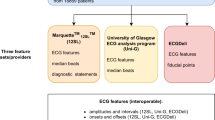Abstract
The definition of the usefulness of the binary classifier from the point of view of reducing the a priori risk of false classification is formulated. Sufficient conditions are proposed to guarantee the utility of a diagnostic test according to this definition. The obtained conditions improved the traditional ROC analysis by limiting the corresponding region of the ROC curve. The line limiting the region of the guaranteed useful test is shown to coincide with the known iso-performance line corresponding to the a priori risk level. The feasible limits of the ratio of losses from target misses and false alarms were determined, according to which a test with appropriate operational characteristics remains useful for screening a disease with a known prevalence. Based on the obtained results, the authors substantiated the efficiency of the new method of the analysis and interpretation of electrocardiograms, which is based on determining the original diagnostic feature in the phase space and enables detecting persons with a high risk of coronary heart disease in the early stages of the disease.
Similar content being viewed by others
References
D. Maxim, R. Niebo, and M. J. Utel, “Screening tests: A review with examples,” Inhal. Toxicol., Vol. 26, Iss. 13, 811–828 (2014). http://doi.org/https://doi.org/10.3109/08958378.2014.955932.
O. Zhukovska, “Decision-making model on potential borrower lending for independent experts group,” in: Proc. IEEE 3rd Intern. Conf. on System Analysis & Intelligent Computing (SAIC) (Kyiv, Ukraine, Oct. 4–7, 2022), IEEE (2022), pp. 118–121. http://doi.org/https://doi.org/10.1109/SAIC57818.2022.9923015.
C. Dendek and J. Mańdziuk, “Improving performance of a binary classifier by training set selection,” in: V. Kurková, R. Neruda, and J. Koutník (eds.), Artificial Neural Networks — ICANN 2008. Lecture Notes in Computer Science, Vol. 5163, Springer, Berlin–Heidelberg (2008), pp. 128–135. https://doi.org/10.1007/978-3-540-87536-9_14.
C. E. Metz, “Fundamental ROC analysis,” in: R. L. Van Metter, J. Beutel, and H. L. Kundel (eds.), Handbook of Medical Imaging, Vol. 1, Physics and Psychophysics, Ch. 15, SPIE Press, Bellingham (2000), pp. 751–769. https://doi.org/10.1117/3.832716.ch15.
T. Fawcett, “Using rule sets to maximize ROC performance,” in: Proc. IEEE Intern. Conf. on Data Mining (ICDM-2001), IEEE Computer Society (2001), pp. 131–138. https://doi.org/10.1109/ICDM.2001.989510.
P. Flach and S. Wu, “Repairing concavities in ROC curves,” in: Proc. 2003 UK Workshop on Computational Intelligence, University of Bristol (2003), pp. 38–44.
P. Sonego, A. Kocsor, and S. Pongor, “ROC analysis: Applications to the classification of biological sequences and 3D structures,” Brief. Bioinform., Vol. 9, Iss. 3, 198–209 (2008). https://doi.org/10.1093/bib/bbm064.
K. Feng, H. Hong, K. Nang, and J. Wang, “Decision making with machine learning and ROC curves,” arXiv:1905.02810v1 [stat.ME] 5 May (2019). https://doi.org/10.48550/arXiv.1905.02810.
J. Davis and M. Goadrich, “The relationship between Precision-Recall and ROC curves” in: Proc. 23rd Intern. Conf. on Machine Learning (ICML’06), Association for Computing Machinery, New York (2006), pp. 233–240. https://doi.org/10.1145/1143844.1143874.
W. B. van den Hout, “The area under an ROC curve with limited information,” Med. Decis. Making, Vol. 23, Iss. 2, 160–166 (2003). https://doi.org/10.1177/0272989X03251246.
M. S. Pepe, G. Longton, and H. Janes, “Estimation and comparison of receiver operating characteristic curves,” Stata J., Vol. 9, No. 1, 1–16 (2009). https://doi.org/https://doi.org/10.1177/1536867X0900900101.
T. A. Alonzo and M. S. Pepe, “Distribution-free ROC analysis using binary regression techniques,” Biostatistics, Vol. 3, Iss. 3, 421–432 (2002). https://doi.org/10.1093/biostatistics/3.3.421.
F. Provost and T. Fawcett, “Robust classification for imprecise environments,” Machine Learning, Vol. 42, No. 3, 203–231 (2001). https://doi.org/https://doi.org/10.1023/A:1007601015854.
M. Majnik and Z. Bosnić, “ROC analysis of classifiers in machine learning: A survey,” Intell. Data Anal., Vol. 17, No. 3, 531–558 (2013). https://doi.org/https://doi.org/10.3233/IDA-130592.
N. Hu, “Using receiver operating characteristic (ROC) analysis to evaluate information-based decision-making,” in: M. Khosrow-Pour, D.B.A. (ed.), Advanced Methodologies and Technologies in Business Operations and Management, IGI Global, Hershey, PA (2019), pp. 764–776. https://doi.org/10.4018/978-1-5225-7362-3.ch057.
D. J. Hand and R. J. Till, “A simple generalization of the area under the ROC curve to multiple class classification problems,” Machine Learning, Vol. 45, No. 2, 171–186 (2001). https://doi.org/https://doi.org/10.1023/A:1010920819831.
C. Ferri, J. Hernández-Orallo, and M. A. Salido, “Volume under the ROC surface for multi-class problems,” in: N. LavračD. Gamberger, H. Blockeel, and L. Todorovski (eds.), Machine Learning: ECML 2003. ECML 2003; Lecture Notes in Computer Science, Vol. 2837, Springer, Berlin–Heidelberg (2003), pp. 108–120. https://doi.org/10.1007/978-3-540-39857-8_12.
D. C. Edwards, C. E. Metz, and M. A. Kupinski, “Ideal observers and optimal ROC hypersurfaces in N-class classification,” IEEE Trans. Med. Imaging, Vol. 23, No. 7, 891–895 (2004). https://doi.org/https://doi.org/10.1109/TMI.2004.828358.
D. C. Edwards, C. E. Metz, and R. M. Nishikawa, “The hypervolume under the ROC hypersurface of “Near-Guessing” and “Near-Perfect” observers in N-class classification tasks,” IEEE Trans. Med. Imaging, Vol. 24, No. 3, 293–299 (2005). https://doi.org/https://doi.org/10.1109/tmi.2004.841227.
X. He and E. C. Fry, “An optimal three-class linear observer derived from decision theory,” IEEE Trans. Med. Imaging, Vol. 26, No. 1, 77–83 (2007). https://doi.org/https://doi.org/10.1109/TMI.2006.885335.
B. Sahiner, H.-P. Chan, and L. M. Hadjiiski, “Performance analysis of 3-class classifiers: Properties of the 3D ROC surface and the normalized volume under the surface,” IEEE Trans. Med. Imaging, Vol. 27, No. 2, 215–227 (2008). https://doi.org/https://doi.org/10.1109/TMI.2007.905822.
T. Fawcett, “ROC graphs with instance-varying costs,” Pattern Recognit. Lett., Vol. 27, Iss. 8, 882–891 (2006). https://doi.org/10.1016/j.patrec.2005.10.012.
R. Meekins, S. Adams, P. A. Beling, K. Farinholt, N. Hipwell, A. Chaudhry, S. Polter, and Q. Dong, “Cost-sensitive classifier selection when there is additional cost information,” Proc. Mach. Learn. Res., Vol. 88, 17–30 (2018).
R. C. Holte and C. Drummond, “Cost-sensitive classifier evaluation using cost curves,” in: T. Washio, E. Suzuki, K. M. Ting, and A. Inokuchi (eds.), Advances in Knowledge Discovery and Data Mining, PAKDD 2008; Lecture Notes in Computer Science, Vol. 5012, Springer, Berlin–Heidelberg (2008), pp. 26–29. https://doi.org/10.1007/978-3-540-68125-0_4.
L. S. Fainzilberg, “Plausible but groundless premises when constructing diagnostic models,” J. Autom. Inform. Sci., Vol. 52, Iss. 5, 38–50 (2020). https://doi.org/10.1615/JAutomatInfScien.v52.i5.40.
L. S. Fainzilberg, “Conditions of utility of diagnostic tests from the point of view of the statistical theory of decision making,” J. Autom. Inform. Sci., Vol. 35, Iss. 4, 63–73 (2003). https://doi.org/10.1615/JAutomatInfScien.v35.i4.30.
L. S. Fainzilberg, “New opportunities of phasegraphy in medical practice,” Sci. Innov., Vol. 1, Iss. 3, 37–50 (2017). https://doi.org/10.15407/scine13.03.037.
L. S. Fainzilberg, “New approaches to the analysis and interpretation of the shape of cyclic signals,” Cybern. Syst. Analysis, Vol. 56, No. 4, 665–674 (2020). https://doi.org/10.1007/s10559-020-00283-0.
Author information
Authors and Affiliations
Corresponding author
Additional information
Translated from Kibernetyka ta Systemnyi Analiz, No. 3, May–June, 2023, pp. 95–105
Rights and permissions
Springer Nature or its licensor (e.g. a society or other partner) holds exclusive rights to this article under a publishing agreement with the author(s) or other rightsholder(s); author self-archiving of the accepted manuscript version of this article is solely governed by the terms of such publishing agreement and applicable law.
About this article
Cite this article
Zhukovska, O.A., Fainzilberg, L.S. Evaluating the Usefulness of Binary Classifier Based on Enhanced ROC Analysis. Cybern Syst Anal 59, 439–448 (2023). https://doi.org/10.1007/s10559-023-00578-y
Received:
Published:
Issue Date:
DOI: https://doi.org/10.1007/s10559-023-00578-y




